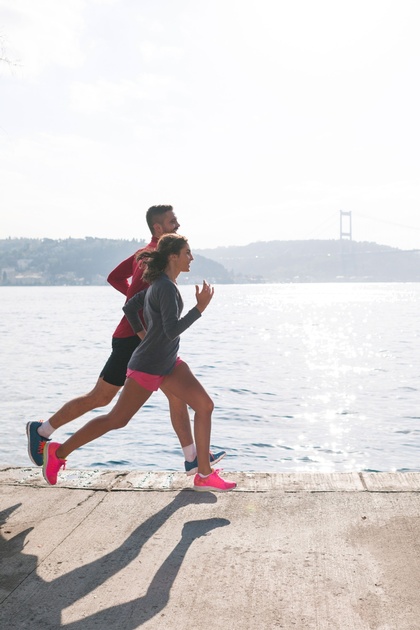
Running is much more than «just» running
Anyone who enjoys running is pursuing their own running career with all its progressions. To ensure this runs smoothly over the long term, you need to diligently build your personal “running house”. Here’s how!
Running is an extremely efficient and simple kind of sport. Tie up your shoes and off you go, anywhere and anytime. However, the simplicity also has its pitfalls. Those who enjoy running tend to run more often, further, and also faster. But take note: if you «only» run, you will sooner or later head for disaster in terms of overload disorders. You should therefore regard running as a house that you constantly need to maintain, renovate and also extend to ensure its upkeep in the long term. Here are ten points that make up a fully-fledged runner.
1. Run regularly
Steady endurance runs, preferably for longer than 30 minutes, form the basis of every runner. It sounds so trite but is generally the most important advice at the outset: if you want to get better, you need to train more. For a versatile basic training program, your everyday training should include sports with a constant load, such as cycling, swimming, skating, or cross-country skiing right from the start.
2. Strengthen your muscles
If you run, you need a strong muscle corset. If you don’t have good core stability, you use your hips to evade the impact, your leg axis becomes misaligned, and the joints become overburdened. For this reason, strength training is an absolute must for each and every runner. With a bit of imagination, you can easily do strength training on your usual running lap. Or on the Vita Parcours. Or in a fitness centre using equipment or in group training to groovy music.
3. Stretching for greater flexibility
You also need to maintain your flexibility. The older you get, the more you need to do stretching or gymnastic exercises. Particularly useful are gymnastic exercises during which you rotate your torso, stretch your hips, or swing your shoulders. A Vita Parcours fitness trail is ideal because it provides you with exercise examples. It is best to stretch after a training unit and after showering. And not only your foot, leg and hip muscles (calves, anterior and posterior thighs, gluteal muscle), but also your shoulders and upper body.
4. Train your coordination skills
In the vast majority of cases, the normal runner is - to put it favourably - not a world champion when it comes to coordination, but usually lacks the fine motor skills for skipping or criss cross jumps sideways. Therefore: skipping, kicking your buttocks, running sideways and backwards, short quick steps forwards and backwards – everything that breaks up the usual motion sequence, is good for you.
5. Work on speed
You usually lose speed as you get older. And yet speed is good for any athlete. Important to know: you won’t train your speed with a «fast» 10-minute run, but only with sprints during which you run really fast. Short but fast, is the motto. It is best to practice such sprints on continuous and slightly sloping terrain. This will thus keep the strain on the musculoskeletal system in check.
6. Vary the exertion level
Anyone who always runs at a heart rate of 120 may indeed be able to run increasingly longer at this intensity but will quickly run out of steam when they suddenly have to run at a heart rate of 160. The following therefore applies: different exertion levels form the ingredients for a versatile running menu. Only a highly varied composition of intensity levels will ensure that new stimuli can be constantly introduced. Three levels are sufficient for beginners (relaxed, medium and rigorous). In practice, you can do one continuous training unit at one level and the next at a different level.
7. Jump!
The specific strength of the legs can not only be built up through targeted training in the gym but can also be efficiently boosted with jumps. Running jumps strengthen the body and improve your coordination and running technique. But take note: the jumps are not as easy and dynamic as they look. When doing jumping exercises, start with the basics first and only increase the duration and intensity slowly.
8. Complete hill runs
Hill runs offer the perfect opportunity to integrate strength and stamina into your running. Hill runs place great demands on the muscles and the cardiovascular system (take a sufficient break to regenerate afterwards), but not on the musculoskeletal system. The principle is simple. Run uphill during the exertion time, then (depending on the terrain) take a break by either marching or jog-trotting really relaxed back to the starting point.
9. Challenge your head
If you want to summon your best performance in a competition you will need to leave your comfort zone – and that is definitely unpleasant. This is known as speed endurance in specialist jargon. It refers to the bite and the ability to endure increasingly longer periods of time at your limit. For the right «bite», various forms of training are suitable, such as fast continuous runs, speed variations, and intervals.
10. Run «naked»
You never go running without a mobile phone or GPS watch? Then you should definitely do so now and again. Observe how your body and heartbeat react under which load. You will thus train your body awareness and become better at assigning your feeling to the different loads and speeds. It is also good for the mind to go running without any digital surveillance now and again.
Foto:iStock.com
This may be of interest for you too


